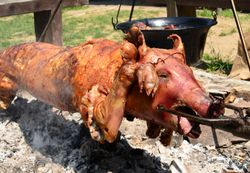An Introduction to Filipino Cooking Methods

The next time you want to order in, try dishes from a Filipino restaurant. This style of cooking mixes Asian and Western influences to create simple, delicious recipes everyone will enjoy. Here's some insight into the cooking methods, ingredients, and meals that make this cuisine unique.
Influences on Filipino Food
Chinese
Chinese influence began during the 11th century when traders brought in white rice, which is served as fried rice or as a side along with brisket and fish. Many dishes also include Asian noodles, like fried or rice noodles. Ginger is a common Asian ingredient, often used with garlic in shrimp and egg dishes or in meat marinades.
Spanish
In the 16th century, the Spanish colonized the Philippines, bringing Catholicism to the islands as well as new ingredients. Paella grew popular using the local seafood along with a mix of saffron, ham, and cured sausage. Olive oil, paprika, and saffron were introduced too.
American
The Philippines became a U.S. territory in 1899. This connection brought convenience cooking to Filipino culture as Filipinos began using pressure cookers and pre-cooking and freezing ingredients. They were also introduced to fried chicken, salad, and hamburgers.
Cooking Methods
Grilling
Grilling is known as ihaw. The Philippines feature over 7,000 islands, making seafood a go-to for any grilled meal. Filipinos dine on grilled shrimp, squid, crabs, and fish along with chicken, pork, and beef. Grilling uses charcoal to create a smokey flavor.
Roasting
 Roasting is also known as lechon. Many Filipino restaurants serve roasted pig to celebrate big occasions like weddings and graduations. This delicious preparation provides large meals on-site, whether you’re hosting a family reunion at a park or a wedding at a beach. Lechon manok, or roasted chicken, is also popular.
Roasting is also known as lechon. Many Filipino restaurants serve roasted pig to celebrate big occasions like weddings and graduations. This delicious preparation provides large meals on-site, whether you’re hosting a family reunion at a park or a wedding at a beach. Lechon manok, or roasted chicken, is also popular.
Steaming
Ingredients are wrapped in banana leaves before steaming them in a rounded pan. The leaves hold in moisture, ensuring the contents don’t dry out.
Boiling
Nilaga means boiling. Bulalo is a traditional dish that features boiled leg marrow with meat and cabbage. Nilagang baka or boiled beef soup features brisket boiled until it falls off the bone, plus green beans, bok choy, carrots, and chopped potatoes.
Adobo
Filipinos preserve meats or vegetables with garlic, vinegar, and pepper in a process called adobo. This method predates refrigeration to prevent spoiling and offers a spicy, sour dish to enjoy with rice or noodles.
Head to Da Ultimate Grindz in Waipahu, HI, to try Filipino cooking. The family-owned and -operated Filipino restaurant offers all-day fare and catering, including favorites like pork adobo and pancit miki. Call (808) 888-3872 to place an order, or visit the website to see the menu.
About the Business
Have a question? Ask the experts!
Send your question

